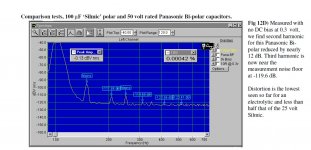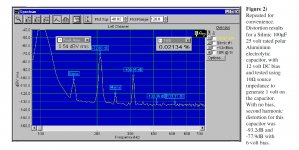Where is the fun in using appropriate component values, and so not needing to use fashionable component brands?
If you are interested to try the "perfectly linear electrolytic capacitor" rule of thumb found in Douglas Self's book Small Signal Audio Design (2nd edition), Figure 2.21, <snip>
Well this is a revelation, to me at least! And here all this time I thought that the only way to approach "perfectly linear" output was with dual rails and direct coupling.
I wonder how much voltage rating matters when one follows this generous capacitance formula. I ask this only because according to Bateman's many measurements, higher voltage rating always lowers distortion (specifically H2 harmonic, thus decreasing H2/H3 ratio) considerably. But this is probably based on situations when the capacitance values are more typical--say (under?)scaled to create a 2Hz corner frequency rather than accomodate this current-carrying requirement.
Mark have you seen this borne out in practice: they all sound the same if sized according to Self's guideline?
It seems to me that the person you should ask is Douglas Self, himself. He participates on diyAudio from time to time.
Be sure to read that entire section of his book beforehand, including the portion where he compares 1000uF/25V against 1000uF/16V against 1000uF/6.3V electrolytics, so you don't accidentally ask Mr. Self any embarrassingly uninformed questions.
Be sure to read that entire section of his book beforehand, including the portion where he compares 1000uF/25V against 1000uF/16V against 1000uF/6.3V electrolytics, so you don't accidentally ask Mr. Self any embarrassingly uninformed questions.
This is not the first time I have been referred to Self's book for sage advice. Probably means I should pick it up. 🙂. Still curious if your ears find his claim to be true.
Diy audio is a really fascinating hobby. It’s good to read & learn from books unfortunately many a times through lots of trail n error or intensive tweaking, the results that we get is far from what books will ever tell us. Crux of it is, you really have to get your hands dirty to discover & if your advanterous enough to think out of the box, results that you attain might astonish you
Cheers
Cheers
Well,
IMHO you should consider using a bipolar cap. You are passing an AC signal thru it and from Batman's work it was quite plain that a bipolar cap has quite a bit less distortion that polar electrolytic for this use.
Also, he found that the higher the voltage rating, especially with a DC bias, the lower the distortion.
Regards,
Greg
IMHO you should consider using a bipolar cap. You are passing an AC signal thru it and from Batman's work it was quite plain that a bipolar cap has quite a bit less distortion that polar electrolytic for this use.
Also, he found that the higher the voltage rating, especially with a DC bias, the lower the distortion.
Regards,
Greg
If your asking me Greg yes bipolar should be more ideal but ut also depends on the caps that’s used. Example Nichicon Es, it’s got a very nice sound to it but it does make images, instruments etc to sound wider than taller & the highs aren’t that good . If your amp sounds bright, this might be a good choice. I did mention that Kz 50v sounds better than 25v. Perhaps this could be due to it’s lower esr. Also I have found caps of same brand same value & voltage but different package size to sound dfferent, meaning short & stubby not as good as slim & tall
Cheers
Cheers
In electronics, as in other branches of engineering, it is often the case that those who feel that they have gone beyond the books have in fact not yet attained the 'book level' and are actually lagging behind. For example, using the wrong component value so having to swap around to get a preferred distortion.
IRemember that Self's data says ANY electrolytic capacitor, from ANY manufacturer, will be perfectly linear when delivering 50mA to a load* ... as long as that electrolytic capacitor is 10,000 microfarads or greater. Even the $1.44 capacitor shown here.
*at frequencies of 62 rad/sec and higher
A bit of info to back this up - if you like repeatable measurements...
Why are people obsessed with coupling caps? | SYclotron Audio
Why are people obsessed with coupling caps? Part 2 | SYclotron Audio
Capacitor Obsessions- The Zombie Awakes (edited to add data 2/21/18) | SYclotron Audio
Sigh, more capacitor nonsense | SYclotron Audio
Hi,
Regarding: "If your asking me Greg yes bipolar should be more ideal ..."
Not should be, according to Bateman's research, would be about 1/4 the distortion of a regular electrolytic cap. To me that is good enough to make it a real contender.
Greg
Regarding: "If your asking me Greg yes bipolar should be more ideal ..."
Not should be, according to Bateman's research, would be about 1/4 the distortion of a regular electrolytic cap. To me that is good enough to make it a real contender.
Greg
I don't have the article. Does he test back-to-back polarized electros acting as a nonpolar?
Are back-to-back polarized electros as good as a nonpolar in this position?
Thanks
Are back-to-back polarized electros as good as a nonpolar in this position?
Thanks
Quoting SY: “Bateman articles use test conditions that are more suitable for crossover capacitor applications than coupling, and indeed in speaker crossovers, some of the capacitor imperfections can edge toward audibility. But for coupling caps, Bateman’s analysis is largely irrelevant.”
If you are interested to try the "perfectly linear electrolytic capacitor" rule of thumb found in Douglas Self's book Small Signal Audio Design (2nd edition), Figure 2.21,
then I recommend you extract the required "AC current delivered into headphones" from the handy table in this web page. When I quickly scan the table, I observe that AC current delivered into headphones is 50mA or less, for about 95% of the headphones listed.
Armed with the necessary numerical values, we simply plug and chug in Self's rule of thumb. AC voltage = 0.08 , AC current = 0.05, frequency = 62 radians/second. And presto, out pops the answer: C >= ten millifarads. (ten thousand microfarads).
For those who dislike techobabble argot obfuscation (I mean, who cares for rads/sec), here's a DIY-friendly formula:
C[uF] = 1000 * Icap[mA] / (6.28 * 0.08 * Fmin[Hz])
But, having actually more than once listened to fairly excessive (headphone) coupling caps both bipolar and single-ended, cheap and more expensive, and actually having some very nice 10.000uF FTcap axials around, I can say with full authority that I myself personally didn't like the overbloated sound projection that comes with such large capacitance. So in this case I disagree with D.Self (I mean not mathematically of course, but in this exact practical application).
I have "listened to" various type caps into mid-range pro-audio cans (K240, Ultrasone DJpro) and quite a number of consumer-grade in-ear and over-ear cans (from Senns, Sony etc. to no-name OEM chinese jobs) and differences I observed were uniformly repeatable and more-or-less apparent across whole range of different can types and impedances.
My observation what was "best" was a simple old formula that basically says that it is good to proportion the coupling caps to a decade below the corner freq. of interest. Then "voice" your application with a cap type of your choice and price-tag (which is of course an important factor). Done.
YMMV
P.s. you can to some extent mimick a certain brand "house sound" on the cheap if you use a slightly under-specced Samwha RD for coupling; at least 2 in signal path.
I can say with full authority that I myself personally didn't like the overbloated sound projection that comes with such large capacitance.
... it is good to proportion the coupling caps to a decade below the corner freq. of interest. Then "voice" your application with a cap type of your choice and price-tag (which is of course an important factor)
Wow. Let's try a thought experiment.
Let's suppose you proportion the headphone output coupling cap to a decade below the corner frequency, and let's further suppose that you select a cap type of your choice that is "voiced" as you think best. We'll call it "X microfarads".
Part 1: listen to the amplifier + coupling cap + headphones.
Now we calculate the integer N = (10000uF / Xuf).
Part 2: connect another N of these exact same capacitors in parallel to the original coupling capacitor, and again listen to the amplifier + (parallel coupling caps) + headphones
The outcome of this experiment is: Part 2 sounds different than Part 1 (!), in fact Part 2 sounds worse than Part 1 (!!!).
One well-chosen capacitor sounds excellent, but when you connect N of these well-chosen capacitors in parallel, the sound is "overbloated" and inferior.
Wow. I find this very difficult to believe.
Anti,
Interesting that 10,000uF sounds bloated to you. I wonder what electrical parameters suffer when stepping up to a giant cap. Certainly we get a lot more inductance and perhaps greater potential for EMI pickup and microphonics. Or maybe the degraded sound simply comes from feeding sub-bass frequencies to a 50mm (or less) driver.
Interesting that 10,000uF sounds bloated to you. I wonder what electrical parameters suffer when stepping up to a giant cap. Certainly we get a lot more inductance and perhaps greater potential for EMI pickup and microphonics. Or maybe the degraded sound simply comes from feeding sub-bass frequencies to a 50mm (or less) driver.
Hello,
Here is where you can find Bateman's article (for the most part).
Fail to see how less distortion does not apply to any application where signal is going thru it. But then I don't see how obscenely expensive caps work that much better either.
Cyril Bateman's Capacitor Sound articles | Linear Audio NL
Regards,
Greg
Here is where you can find Bateman's article (for the most part).
Fail to see how less distortion does not apply to any application where signal is going thru it. But then I don't see how obscenely expensive caps work that much better either.
Cyril Bateman's Capacitor Sound articles | Linear Audio NL
Regards,
Greg
The giant Panasonics 10.000uF linked earlier are smaller than the 1000uF KZ, same dia, same inductance.
Anti,
Interesting that 10,000uF sounds bloated to you. I wonder what electrical parameters suffer when stepping up to a giant cap. Certainly we get a lot more inductance and perhaps greater potential for EMI pickup and microphonics. Or maybe the degraded sound simply comes from feeding sub-bass frequencies to a 50mm (or less) driver.
I don't have a slightest clue or an explanation to what exactly is causing that (soakage?). Having said that, I found that even 4700uF-into-32 Ohm various consumer cans gives that "bloated" feel. Even with 3300uF (cca 1.5Hz corner or so). 2200uF is passable (cca 2Hz) ... but to me it depends on the cap brand. As you noted, some are better than others (IME low-ESR "industrial" types).
With 50/64 Ohm both I liked the 1500uF best (1,9Hz and 1,6Hz corner, but with a 50mm driver).
Actual experience IME goes a little against the math.
Last edited:
- Home
- Design & Build
- Parts
- Miniature electrolytic capacitors shootout - Best for Coupling to Headphones?


